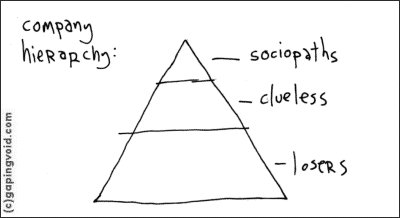Organizational Literacy
The art and skill of understanding how organizations function and grow. Better organizational literacy makes it easier to understand why you and others are doing what they are doing in an organization.
McLeod Hierarchy
for more see McLeod Hierarchy

Navigating Organizations
From Tom Critchlow's Navigating Power & Status
- Every company has two org charts: the public one and the invisible one, created by status games people play.
- Draw several maps over days as your understanding evolves. Figure out who gets more stuff done. Figure out who, if anyone is sidelined.
- Look for who gets pulled into the room, that's the 1 sign of who has power and influence.
- Types of roles
- Decision makers - not always in the C-Suite. Sometimes subject matter experts can wield outsized amounts of power. Maybe that's one way you can work to seize more influence in an organization?
- Gatekeepers - Can be keepers of time or data.
- Makers - you wield power if you are the only person in the organization who can make something. For example, if you are the only person who can update the website.
- Use the people who have the most power as examples of 'how to get things done' within an organization.
- Also watch out for power potholes - people who have power in name, but not in practice.
- consultants have no place on the map.
The 8 Images of Organization
- organizations as machines
- organizations as brains
- organizations as organisms
- organizations as cultures
- organizations as political systems
- organizations as psychic prisons
- organizations as as systems of change and flux
- organizations systems of domination.
Related
Learning about about organizations as a consulting offering. See Organizational Research.